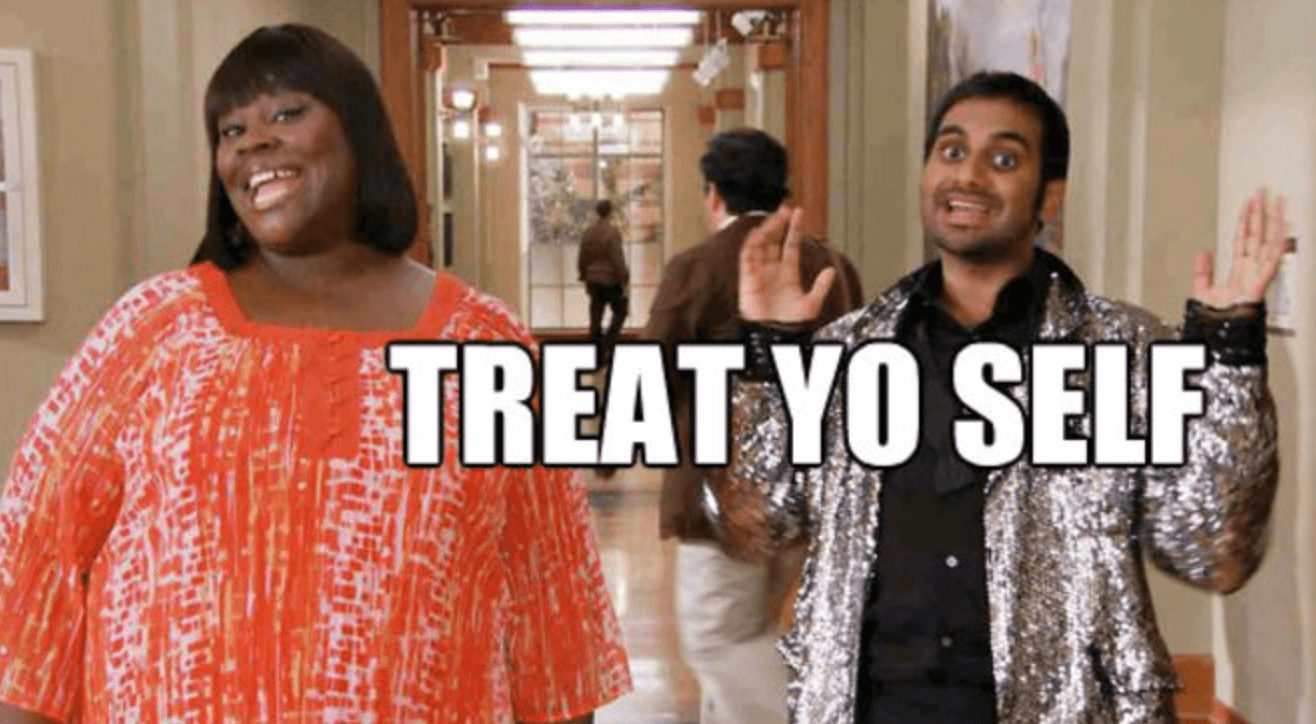How Shopping Can Serve as Strategic Self-Care for Creatives
Heads Up: This post contains a few affiliate links—which means if you click and buy, I may earn a small commission (at no extra cost to you). I only recommend stuff I genuinely love, use, or would gift to my fellow overcaffeinated creatives. With Amazon Prime Day happening July 8–11, now’s actually the perfect time to indulge in a little low-cost, high-reward self-care. Let’s make burnout prevention...a line item.
Sometimes, all it takes is a tiny, intentional splurge—a fresh notebook, a scented candle, a pack of silky pens that glide just right—to spark a creative reset. Not a dopamine-chasing impulse buy, but a purposeful act of self-care.

'Treat Yo Self' Is More Than a Meme
The idea might have started as a punchline from Parks and Recreation, but for burnt-out creatives juggling deadlines and deliverables, “treat yo self” moments can do more than offer comic relief. Thoughtful treats can deliver real psychological benefits—boosting mood, reinforcing motivation, and helping to push through creative fatigue.
When used strategically, shopping becomes less about the stuff and more about the spark. Whether you're freelancing on fumes or deep in a long-form project, small indulgences can function like bookmarks for your brain—mental placeholders that say, “You did something hard. Here’s your reward.”
The Neuroscience Behind Retail Therapy
When we talk about retail therapy, it’s not just a catchy phrase—it’s rooted in real brain chemistry. The key player here is dopamine—the brain’s “feel-good” chemical—spikes when we anticipate or complete a purchase, according to research from Clarity Clinic and Mind Money Balance. That means just browsing can trigger a lift in mood, even before your card hits the checkout page.
And it’s not just brain chemistry—sensory engagement matters too. Walking through colorful aisles, touching different textures, and engaging with new sights distracts the mind from stress or burnout by shifting focus away from negative thoughts. This sensory engagement acts like a mini mental reset button—helping creatives break free from their routine pressures and refresh their emotional state.
Why Creatives Often Undervalue Treating Themselves
Creative professionals frequently juggle tight budgets alongside ambitious goals—and this balancing act often leads them to deprioritize personal rewards. Freelancers especially might feel pressure to funnel every dollar into tools or projects rather than themselves.
Ask any freelancer or creator how they feel about buying something “just for fun,” and you’ll likely hear a familiar narrative: guilt. Many of us are conditioned to believe that spending should go toward the next client tool or invoice tracker—not a pair of fuzzy socks or a new sketchpad.
But that guilt often backfires. According to the American Institute of Business, neglecting personal care in pursuit of productivity can actually undermine it. This guilt creates barriers to embracing “Treat Yo Self” moments as legitimate parts of professional care rather than mere luxury.
The result? Higher burnout risk, lower output, and a dwindling sense of joy in the work itself.
Reframing treats as essential maintenance—not indulgence—helps override that internal pushback. Investing in your own energy is part of the job, not a reward for finishing it.
Using Rewards to Fuel Resilience
Strategic treating is less about splurging and more about scheduling.
When you plan your indulgences (rather than reaching for them out of stress or boredom), you create mile markers of motivation. That matcha latte after a brutal editing pass? It means something. That ceramic mug you’ve been eyeing? Now it’s a trophy for landing a client.
Even better: these micro-rewards serve as burnout buffers. They interrupt endless work loops with brief moments of joy, giving your brain something to look forward to—and your body permission to rest. In short, they make the grind more human.
How to Plan Guilt-Free ‘Treat Yo Self’ Moments
The trick is treating with intention. Set aside a budget line just for joy purchases—nothing overly indulgent, just enough for a couple of small wins, or one larger purchase, each month. Keep it separate from your operating expenses, so it doesn’t blur into “should I really be spending this?”
You can also tie your treats to milestones. Finished a pitch? Take yourself out for your favorite pastry. Hit inbox zero? Queue up that cute new planner. These rituals build positive reinforcement into your workflow, turning productivity into something more sustainable—and yes, more fun.
Tracking indulgence expenses separately, choosing items that are low-cost but high-impact, and practicing mindfulness while you enjoy the reward? That’s how you make treating yourself feel like fuel, not a detour.
Personally, I’ve found that budgeting for small joys—whether it's a cheap pack of stickers to decorate my laptop or a pricer splurge on some high-end blue light glasses to protect my eyes and avoid migraines (no more lost income days thanks to splitting headaches!)—gives me space to recharge without the guilt spiral.
When I treat it as a tool, not a splurge, I stop second-guessing and start showing up fully.
Featured Image: Елизавета Крылова on Unsplash.
